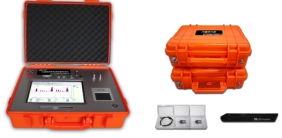News
Uplift detection for underwater detection of Haihe Erdao Gate
On June 13, 2018, Shengtuo Testing was commissioned by Tianjin University to conduct non-destructive testing of the concrete of the Haihe Second Gate Sluice. Professor Liu Donghai from the School of Architecture and Engineering of Tianjin University, Tianjin Water Affairs Bureau, and civil engineering students attended the test. The Haihe Erdao Gate is located on the main stream of the Haihe River in Tianjin. It is an integrated structure of the gate. The project was started in August 1984 and completed in December 1985. The bridge deck is 14.6m wide and the bridge length is 129m. Huang Botai, the chief technical officer of our company, combined with the operation of the sluice, used the Rayleigh wave method (surface wave method) and single reflection method to detect the concrete defects and quality of the sluice floor.


The equipment used in this test is a concrete multi-function non-destructive tester SCE-MATS-S independently developed by Ascendas, as shown below.

The instrument can perform a variety of tests on concrete samples from 10cm, to bridges and dams up to 150m, such as concrete (elastic modulus, strength), thickness, structural size, defects (internal voids, peeling, Surface deterioration), crack position, crack depth, and the like. At the same time, it has a wealth of graphics processing functions: such as elastic wave radar scanning EWR, computer tomography CT, fast planar imaging QPG, 3D slicing technology 3DS and automatic fast processing function.
This underwater test uses the attenuation characteristics of Rayleigh waves to test the crack depth in concrete structures. The method has a large test range and is less affected by the filling, steel and moisture, and is suitable for testing deep cracks. The invention patent has been granted: a method for reducing the test error of the elastic wave signal by using two-direction vibration, patent number: ZL200510021851.5 , which greatly improves the test accuracy and practicality. The single reflection method tests the defects in the horizontal direction, and the key technology is to identify and extract the reflected signals from the test signals.
